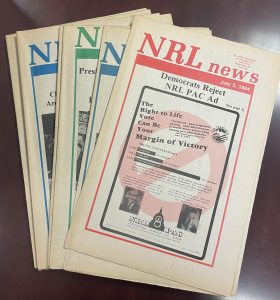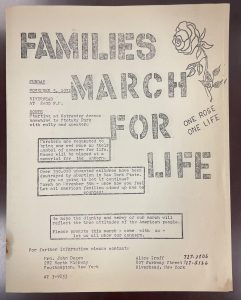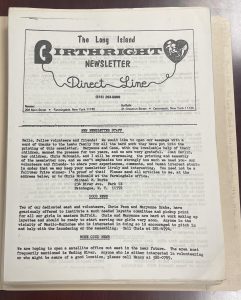Our guest blogger is Rebecca Lemon, a Library and Information Science (LIS) student at Catholic University.
Last semester, as part of my Library and Information Science (LIS) coursework, I had the opportunity to arrange and process two small, related collections, the National Right to Life News Collection and the Long Island Pro-Life Collection , housed in the university’s Special Collections. Both collections were generously donated in 2021 to CUA by the Sisters of Life, a Catholic religious institute based in New York.

Since I had never processed any archival collections before, sitting down to look at the seven boxes of unprocessed materials in front of me felt rather daunting. I took it slowly, though, and began by simply looking through each box and trying to get a sense of what was there. It soon became clear that processing the National Right to Life News collection would be fairly straightforward. The collection contains all the issues of the National Right to Life News published between November 1973 (when it first began) and 1999. Arranging the collection, then, would be a simple matter of putting the issues in acid-free folders according to their date. The Long Island Pro-Life collection, on the other hand, was a very different story. Since this collection documents the grassroots pro-life movement on Long Island during the 1970s-1990s, it contains a wide variety of materials like pamphlets, newspaper and article clippings, newsletters, periodicals, correspondence, books, and other ephemera. Processing this collection appeared as if it would be much more complicated, so I decided to start with the National Right to Life News collection first and then move on to the Long Island Pro-Life collection after I’d had more time to think about the best way to arrange and describe it.

It took me only a few weeks to process and describe the National Right to Life News collection. I arranged the issues in acid-free folders and then labeled them for easy access, writing the collection title, folder title, and issue dates, as well as the collection number, box number, and folder number on each one. This not only makes it easy to locate the right folder at a glance, but also guards against the rare chance that a folder is inadvertently separated from the collection. In that event, enough identifying information is written on the folder itself to be able to locate its correct place.
Successfully processing the National Right to Life News collection gave me enough confidence to begin arranging the Long Island Pro-Life collection. Unlike the National Right to Life News collection, no clear order for arrangement was immediately apparent. I spent a good deal of time sifting through the collection, trying to discover any hints as to its organization that might have been left by the collector(s) of the materials. I found that, though there really was no particular order to the vast majority of the materials in the collection, there was a series of folders which had been labeled with handwritten names. So, I needed to be sure to preserve the general order of this series, but I was free to arrange the rest of the collection in whatever way would make its contents the most accessible. I decided that the best way of striking a balance between making the materials easily accessible and not overly disturbing the collection would be to organize it by format. I created five series in total: 1) Pamphlets, 2) Newsletters and Periodicals, 3) Newspapers and Newspaper Clippings, 4) Subject Files, and 5) Books. The process of sorting the materials into these series also helped me to glean some contextual clues about the origins of the collection. Although the collection was donated by the Sisters of Life, they were not the original collectors of the materials, and we unfortunately do not have any official documentation about the original collector(s). However, while going through the collection, I discovered that several of the newsletters, periodicals, and correspondence are addressed to Mrs. Mary Brennan or her family. The collection also contains some personal papers belonging to Mary Brennan, which document her active involvement in the leadership of the pro-life movement on Long Island during the 1970s-1990s. From this, we can infer that Mary Brennan was most likely the primary collector of the materials in the collection, and so we have indicated that in the finding aid for the collection.

As I learned through my experience with these two collections, archival processing has a lot to do with making educated guesses about the history and previous organization of the collection. The archivist must attempt to get inside the mind of the original collector(s) and find answers to the myriad questions that arise when processing and arranging the collection. For example, why did the collector(s) keep certain things and not others? Did they use a particular method of organization? If so, how can we preserve that method and yet make the materials easily accessible now for researchers in the present day? With a little patience and perseverance, the answers to these questions can be found by retracing the collection’s history through the clues left buried in the collection. In this way, boxes of unorganized papers cease to appear quite so intimidating and become instead an exciting mystery just waiting to be solved.
Interested in learning more about the items in these collections? Make an appointment with CUA Special Collections to come view the materials in person.
Works Cited:
National Right to Life Committee. (n.d.). National Right to Life News.
Shepherd, W. J. The Archivist’s Nook: Catholic University’s Sisters of Life Collections, October 5, 2021.
